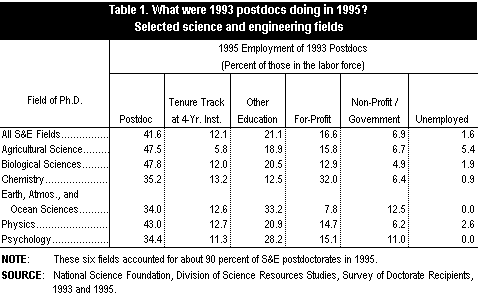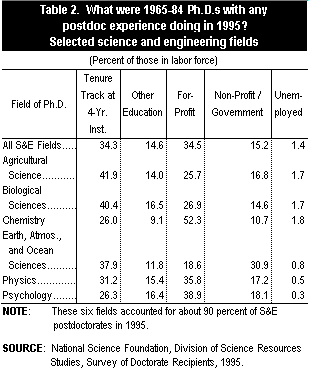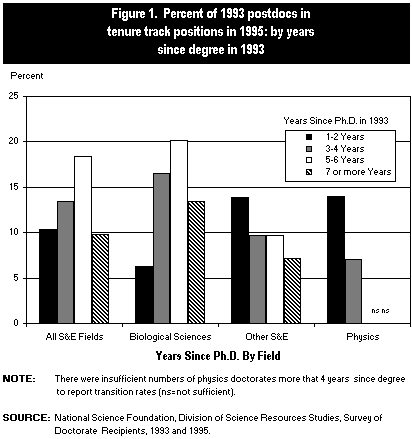
Directorate for Social, Behavioral
and Economic Sciences
NSF 99-307 November 27, 1998
Regets

More than 40 percent of 1993 postdoctorates remained in postdoc positions two years later.
As with earlier cohorts of postdocs, only a minority of 1993 postdocs left for tenure positions.
With increased use of postdoctoral positions or "postdocs" in many fields of science and engineering (S&E)[1] , there is greater interest in where people find employment after completing their postdocs. Anecdotally, postdoc experiences are said to be most valued by academia, and hope for an academic career is held to motivate many postdocs. This issue brief examines the April 1995 career status of S&E doctorates who had been in a postdoc position in April of 1993, with a focus on academic and industrial employment.
A large number remained as postdocs
A large proportion of those in postdoc positions in April 1993-42 percent-remained
in such positions by April 1995. The highest[2]
rates of retention in postdoc status were found in the life sciences (48
percent each in the biological and agricultural sciences) and in physics
(43 percent); rates in the earth, atmospheric, and ocean sciences; psychology;
and chemistry ranged from 34-35 percent. These six S&E fields accounted
for around 90 percent of all S&E postdocs in 1995 (table
1).
Few who left postdocs obtained tenure-track positions
By 1995, about one-third of the 1993 postdocs had found academic employment.
However, only 12 percent were in tenure track positions at 4-year colleges
or universities, a rate that varies little across five of the six major
postdoc fields (the exception was agricultural sciences with 6 percent).
Another 21 percent had appointments ranging from low-pay adjunct teaching
positions to somewhat better paying jobs with research or administrative
responsibilities. Industrial employment was reported by 17 percent; the
remainder was in Government or nonprofit sectors. Fewer than 2 percent
were unemployed, and only a small number—3 percent—reported that they
were employed in a job unrelated to their degree because a job related
to their degree was not available.[3]
Are current post-postdoc job patterns different from
before?
A rough impression was gained of previous postdoc employment transitions
by examining the work status in 1995 of 1965-84 S&E Ph.D.s who were former
postdocs. Approximately equal numbers of these mid to later career doctorates—34-35
percent—were working in private for-profit firms and in tenure track (or
tenured) positions at 4-year institutions respectively[4];
another 15 percent held other academic jobs. The Government and nonprofit
sectors employed another 15 percent. Less than 2 percent were unemployed.
These findings suggest that previous cohorts of postdocs also entered
a wide range of employment sectors besides academia (table
2).
The longer the time since the Ph.D., the lower the
chance for a tenure track appointment
For the biological sciences, the field that dominates the S&E postdoc
numbers, the rate of transition to tenure track positions initially increases
with time since degree: from 7 percent for those only 1-2 years after
their degree in 1993 to 20 percent for those 5-6 years after degree. Only
after 6 years does the rate of transition from postdocs to tenure track
employment decline sharply to 13 percent[5]
(figure 1).
But the pattern was sharply different for postdocs in all other fields combined. For them, the longer the time since earning their doctorates, the lower the likelihood of a tenure track position in 1995. Fourteen percent of 1993 postdocs with degrees earned 1-2 years earlier transitioned to tenure track positions, but only 10 percent of those who had earned degrees 3-6 years earlier and only 7 percent of those more than 6 years since their degrees. This pattern was particularly pronounced for physics postdocs: from 14 percent for those 1-2 years since their doctorates to only 7 percent for those who had earned their degrees 3-4 years earlier.
This Issue Brief was prepared by:
Mark C. Regets
Division of Science Resources Studies
National Science Foundation
4201 Wilson Boulevard, Suite 965
Arlington, VA 22230
703-306-1776 ext. 6923
E-mail: mregets@nsf.gov
SRS data are available through the World Wide Web (http://www.nsf.gov/statistics/). For more information about obtaining reports, contact pubs@nsf.gov. or call (301) 947-2722. For NSF's Telephonic Device for the Deaf, dial (703) 306-0090. In your request, include the NSF publication number and title, your name, and a complete mailing address.


